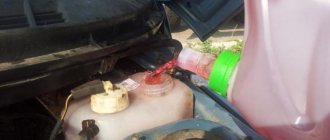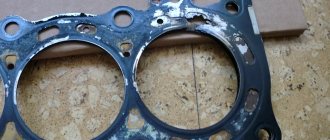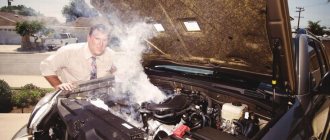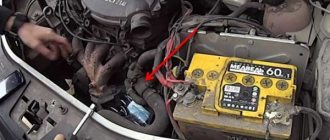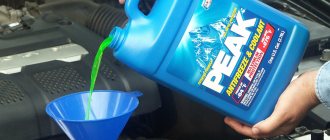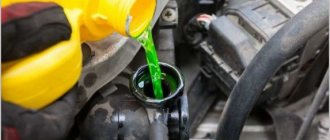A drop in the level of any fluid in a car, including antifreeze, is a serious problem that requires immediate attention. If there are smudges, then there will be no special problems with diagnosis and repair. But there are often cases when the coolant disappears from the tank, and there are no traces of leakage at all, and it is not clear what to do in such a situation.
In this article we will try to figure out what to do, when and where antifreeze goes and what to do with it.
What does the antifreeze level affect?
Antifreeze circulates in the cooling system through various tubes and channels. Before the engine reaches operating temperature, the coolant flows through a small circle. When the temperature reaches +90 °C, the thermostat turns on, which runs antifreeze in a large circle.
During operation, antifreeze expands, increasing in volume by 3-5%. All excess is sent to the expansion tank. When cooled, the liquid is compressed, and its excess flows back into the engine. This prevents the formation of vapor locks that negatively affect the performance of the power unit, and also maintains an optimal coolant level.
But if the coolant level is below normal, a violation of the engine temperature regime occurs. As a result, the cylinder head overheats, cracks form on it and the oil and cooling channels are destroyed. This can be determined by a drop in engine compression and power, increased fuel consumption and other factors that can lead to serious damage.
If the antifreeze is more than the level specified by the manufacturer, the pressure in the cooling system increases, which leads to leaks in the hoses, radiator or expansion tank cap. When cold liquid comes into contact with the radiator, a sharp temperature change occurs. In some cases, this may cause cracks to form.
That is why the level of antifreeze must be strictly observed, since excess or lack of coolant in the system leads to dire consequences for the car engine.
Main signs of an antifreeze leak
First, let's figure out how to determine that antifreeze is really leaving. The following signs may indicate this:
- Constant drop in coolant level
- The stove does not work / does not work well
- Engine overheating even on short trips
- Steam from under the cap of the expansion tank with antifreeze
- White smoke comes out of the exhaust pipe, which is especially noticeable in the warm season.
- Sweetish smell in the car interior
- The appearance of an emulsion in the expansion tank of the cooling system
- Presence of leaks on the radiator housing, pipes, expansion tank of the cooling system, engine, etc.
- An overheating icon appears on the dashboard, the coolant temperature arrow is at or close to the maximum mark
- When you open the coolant expansion tank cap, steam comes out
- The appearance of traces of oily liquid on the floor in the car interior
These signs can appear either separately or in combination, which in turn may indicate a long-standing malfunction of the cooling system.
How to fix a coolant leak
It is quite difficult to restore the tightness of the cooling system on your own. First, you need to find out where the antifreeze was flowing, by the characteristic traces left by the coolant. Work such as replacing a radiator, pipes, pumps should be carried out in a car repair shop, since they require certain skills from the car mechanic and the presence of special equipment.
If the leak is small, then you can use a temporary measure that consists of purchasing and adding automotive sealant to the antifreeze. However, it is worth knowing that the sealant not only covers damage that has occurred in the system - its use negatively affects the further operation of the radiator and car pump. It can clog most of the tubes in the radiator, making it impossible to effectively cool the antifreeze, which will lead to engine overheating. If the sealant gets on the pump impeller, it can also damage it, so it can only be used in extreme cases.
Thanks to the Uremont.com service, you can quickly find a company that provides high-quality repairs and maintenance of the engine cooling system at an affordable cost. With us, any type of work is prompt, high-quality and at a low cost.
Obvious reasons
The first reason why antifreeze may disappear is a leak in the engine radiator. It is very easy to determine this - just inspect it, and also look at the smudges under the car. If there is any crack in the radiator, there will be drops of antifreeze on its surface.
The same applies to the heater radiator. But in this case, it is a little more difficult to diagnose the malfunction, since antifreeze will drip onto the floor of the car. But there are indirect signs that may indicate a breakdown of the heater core: a sweetish smell inside the car, the windows fog up even in dry weather, the presence of an oily coating on the windows.
Hoses and pipes of the cooling system fall under the category of obvious causes. The former suffer especially, since when the engine heats up they expand each time, and when they cool down, they contract. Sooner or later, this leads to their damage, and even a small crack will constantly leak antifreeze.
Another cause of antifreeze leakage is a faulty pump or thermostat. These are two nodes that are responsible for circulating the coolant flow in the system. Typically, leaks are found in areas where the plastic and metal components of the case meet.
Damage to the expansion tank and its cap can also cause antifreeze leakage. If the cap does not hold pressure, the coolant may splash out when warming up. In addition, the tank itself may burst, because it's plastic. And if the lid is faulty, then it can easily break.
All these reasons are the main ones, so they should definitely be checked first.
Troubleshooting
The extent of repair work will depend on the nature of the problem. As a rule, if you notice a problem in the early stages, you can deal with the breakdown yourself.
This is interesting: Engine mounting: principle of operation, purpose, design and replacement
But otherwise, when the problem was discovered a long time ago and nothing was done to fix it, you need to contact a service station or a car repairman.
During the cold season. Such breakdowns in the winter are a very common occurrence, especially for older cars. The reason for this is a decrease in the volume of antifreeze under the influence of low temperatures. Subsequently, it becomes necessary to constantly add it to the expansion tank. This situation indicates that everything is in order with the cooling system. This only confirms the usual reaction of antifreeze in cold weather.
Sometimes drivers dilute antifreeze with water. But such actions are not always justified. This can lead to serious consequences, such as engine failure. Today, there are two types of antifreeze in car stores - ready-to-use and concentrated. Only concentrated substances can be diluted with water.
By adding distilled water to a ready-made liquid, you can significantly disrupt its beneficial properties, which will lead directly to failure. Therefore, before diluting antifreeze with water, you need to study the instructions from the manufacturer.
Violation of the tightness of the expansion tank
If antifreeze leaks, there may be different reasons. Depressurization of the tank is one of them. If the structure of the tank is damaged, then the corresponding antifreeze stains will not be visible on it. This happens due to the evaporation of working fluid from the tank due to its depressurization.
Therefore, if a leak of coolant in large volumes is detected, it is necessary to conduct a visual inspection of the expansion tank for mechanical damage. It is quite difficult to restore the tank yourself, so it is better to replace it immediately.
Expansion tank
If the expansion tank body and/or the caps with the gasket on it are old, then there is a high probability that they have microcracks. Another option is to skip the safety valve on said lid. The simplest thing in this case is to replace the cover and install a new gasket. More difficult is to replace the entire tank (including the lid).
Damage to conductors
In this case, coolant stains will be visible. Finding an antifreeze leak when the conductors are damaged is not difficult. Working fluid can leak not only when the car is running, but also when the engine is turned off.
If characteristic stains from antifreeze are observed the next morning, it is necessary to inspect all connections and components. But before starting work, you need to turn off the engine and wait until the temperature in the system normalizes.
During repair work, it is necessary to check all connections for mechanical damage. They can occur in any part of the system or hose. If certain parts are not visible due to poor access, a mirror can be used. When a certain hose is already very old and completely cracked, the leak can only be removed by completely replacing it. Diagnosis is best done in good lighting.
The cause of the leak may be poorly clamped clamps, as well as dried out rubber seals. In this case, antifreeze leaks from the pipes can be eliminated by replacing the seals and clamps. Timely repairs and diagnostics will help avoid big problems if antifreeze is leaking.
How to detect a leak?
Before repairing or replacing failed parts, you need to clearly understand where exactly the leak is occurring.
The easiest way to detect is visual inspection. It makes it easy to identify areas where antifreeze is leaking by smudges. Most often these are pipes and rubber elements of the system. If leaks cannot be found, the integrity of other elements of the cooling system should be inspected.
The next simple way is to use cardboard. A large sheet of this material is placed under the car during long-term parking. Even with a small leak, drops of antifreeze will fall on it, and then by the location of the drops it will be possible to determine where the leak is coming from.
It would be useful to inspect the connecting clamps. It often happens that it is because of their weakening that coolant begins to ooze. But, even if this is not the case, the clamps should be tightened for preventive purposes.
If all the above steps did not help determine the leak, proceed to inspecting the expansion tank. It needs to be cleaned of contaminants, and then, after warming up the engine, see if any smudges have appeared on the surface of the tank.
There is another way to check. We dismantle the expansion tank and pour the coolant out of it. Next, we connect a pump with a pressure gauge to it and create a pressure inside it of 1 bar through the lid. If the pressure drops, the tank is leaking. The same can be done without removing the tank. When excess pressure is applied to the system, there is a possibility that the leak will manifest itself faster.
Another way to detect leaks is to use a special fluorescent additive. This is a composition that begins to glow when exposed to ultraviolet light. You can find it at any car market. UV liquid is added to the antifreeze, and inspection of suspected leak sites is carried out with the engine running. This method is the most effective, as it allows you to identify even small leaks and places hidden from normal visual inspection.
It should be noted that many modern antifreezes already contain fluorescent additives.
Why is the pump leaking?
Insufficient sealing of the pump impeller shaft is the main cause of antifreeze leakage. The rubber cuff is responsible for sealing. Over time, the oil seal becomes dull and wears out, which is why it begins to loosely adhere to the turbine impeller shaft. In the case of using low-quality antifreeze or runout on the shaft resulting from poor components, the service life of the oil seal is significantly reduced.
To prevent antifreeze leakage through the oil seal from leading to washing out the lubricant from the rotation bearings, a drain hole is provided at the bottom of the housing. If the pump is rotated not by a toothed belt, but by a chain, the pump is installed in a special housing. When replacing the pump, it is necessary to install it so that the drain hole of the pump liner coincides with the drain hole in the housing. If you do not do this and do not pay attention to the hole clogged with dirt, in the event of a leak, antifreeze will flow through the oil seal into the engine.
Antifreeze entering the pan leads to the appearance of a milky emulsion. Due to dilution, the oil loses its lubricating and viscosity properties. Even short-term operation of the engine on emulsion results in wear of the rubbing pairs and expensive engine capital.
Video: How to easily fix antifreeze leaks on AUTO sealant check!!
What to do if the antifreeze runs out but there are no signs of leakage?
What if, after inspecting all possible places where antifreeze might be oozing, nothing is found, but the coolant is leaving?
The fact is that in addition to open leaks, there may also be hidden ones, which are very dangerous. An engine is a composite structure that can be divided into a block and a cylinder head. Between them lies the cylinder head gasket, which acts as a sealant.
In the block itself and the head there are channels through which antifreeze circulates, cooling the engine. This allows you to maintain the operating temperature of the internal combustion engine in the region of 90-100 °C. Accordingly, in the absence of coolant, the engine temperature rises significantly, which entails unpleasant consequences, including replacing the power unit.
The antifreeze itself also passes through the gasket, which has special channels. If the cylinder head gasket is damaged, does not fit well, or is completely defective, the sealing of the channels is compromised and coolant can enter the engine cylinders, then into the combustion chamber and exhaust pipe. At the same time, the antifreeze level will constantly decrease, and you will not find visible leaks.
Such hidden leaks can be identified by the following signs:
- Thick white smoke from the exhaust pipe
- Increasing engine oil level
- Coolant will constantly leave the reservoir
- The engine oil will be interspersed with antifreeze, as evidenced by bubbles
These signs indicate that the gasket has reached the end of its service life and urgently needs to be replaced. If you postpone this procedure, antifreeze may get into the engine oil. This can lead to more serious problems than replacing the gasket.
The oil is mixed with the coolant and turns into an emulsion, which coagulates, causing all channels to become clogged. It will not be able to provide normal lubrication of the engine cylinders, which will cause the piston rings to wear out. In addition, such an emulsion clogs the crankshaft channels, which will increase wear and cause the bearings in which it rotates to rotate.
This is the main hidden reason why the antifreeze level may drop without visible traces. However, the coolant in the engine also circulates through other channels of the system, and there are also gaskets that wear out, leading to leaks.
Leak points along the outer contour
- Loose clamps on the cooling system pipes.
- Broken engine cooling radiator. Most often, honeycombs are destroyed due to the impact of stones when moving at high speed. Often, weakening of the radiator walls occurs due to poor quality antifreeze.
- Crack in the coolant reservoir. The tank itself consists of two parts, which are soldered together at the factory. A leak at the joint is a consequence of non-compliance with the manufacturing technology.
- Heater radiator leaking.
- Cracks in the plastic fittings of the radiator, thermostat, and heater tap appear due to the natural aging of the plastic due to a large number of heating and cooling cycles. Due to the fault of the repairmen, such a malfunction occurs when the pipes are removed/installed carelessly or the clamps are tightened with an excessively strong torque.
- Cracking of rubber pipes. First, cracks appear in places where pipes fit on metal and plastic fittings. The pressure exerted by the clamps over time leads to a weakening of the internal structure of the hoses. Often the process is accelerated due to the use of low-quality clamps, which, when tightened, cut into the rubber pipes. The tightening torque is also important - overtightened clamps significantly shorten the service life of the hoses. It has an effect on rubber products and low-quality antifreeze. The pipes begin to crumble from the inside and crack. An important role is played by the quality of products installed by the manufacturer at the factory or by the owner when repairing the car.
There is a known problem of bursting cooling pipes from the thermostat to the exhaust gas recirculation system on 1.3 MultiJet diesel engines. Often the problem arises even before the mileage of 200 thousand km.
The catch is that the pipes are located on the back of the engine block, and therefore it is extremely difficult to notice fogging in time. The main danger is that, according to statistics, hoses most often burst during prolonged high pressure inside the system, when the car, for example, is driving along the highway. And since with a sudden loss of a large volume of coolant, the temperature sensor is no longer washed by antifreeze, the readings on the dashboard remain normal for some time. Naturally, the consequence of such a breakdown is engine overheating. Therefore, if antifreeze or antifreeze leaks on your car, quickly try to find the location of the leak.
How to deal with hidden reasons?
If a hidden leak is suspected, the engine gasket should be replaced. In many cases, this is the source of such problems. If not, opening the engine will reveal what caused the hidden leak. Sometimes this may be due to cracks in the cylinder block or for another reason.
The replacement procedure only seems complicated, but almost every car owner can do it on his own.
First you need to purchase a gasket that fits your existing engine. Then we remove the cylinder head cover. It is usually secured with 8-12 bolts. First you need to remove the pipes connected to it, the air filter and other elements that will interfere in the future. After this, unscrew the block head itself. The bolts that secure it in place must be tightly tightened. Therefore, if any of them gives in easily, it is worth stretching it. Perhaps the leak occurred precisely because of him.
If this action does not help, remove the head. At this stage it will be possible to detect the leak. We replace the old gasket with a new one and assemble all the parts in the reverse order. Particular attention should be paid to tightening the cylinder head. It is performed in a checkerboard pattern using a torque wrench, thanks to which you can adjust the tightening force.
To summarize the above, it should be said that antifreeze leakage is a common problem that any car owner may encounter. No one is protected from a leaky pipe, a crack in the reservoir, or a worn out engine gasket. The most important thing in these situations is not to delay identifying and eliminating faults. Otherwise, all this can result in serious damage and large financial costs.
You should also not neglect a banal preventive inspection of the cooling system. In most cases, leaks can be prevented before they become a real problem.

